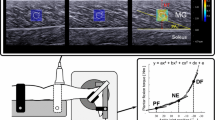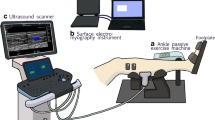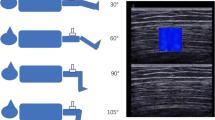Abstract
Purpose
We investigated the relationship between intramuscular adipose tissue (IntraMAT) and muscle stiffness (passive and mechanical) and lengthening in young individuals, hypothesizing that (1) passive muscle stiffness is negatively correlated with the IntraMAT content, and (2) the IntraMAT content is negatively correlated with mechanical changes in muscle stiffness and fascicle length during passive dorsiflexion.
Methods
Twenty men and women (20.3 ± 1.3 years) participated in this study. Axial T1-weighted magnetic resonance imaging was performed at the thickest point of the medial gastrocnemius (MG) to measure the IntraMAT cross-sectional area (CSA) and muscle tissue CSA (units; cm2). The shear wave velocity (SWV) and fascicle length at the three ankle joint angles, namely 15° with plantarflexion (PF15), 0° with neutral position (NP), and 15° with dorsiflexion (DF15), were measured as parameters of muscle stiffness (unit; m/s) and lengthening (unit; cm) using ultrasound shear wave elastography and B-mode imaging. We further calculated the changes in SWV and fascicle length from PF15 to NP and from NP to DF15 as mechanical muscle stiffness and lengthening, respectively.
Results
There was a relationship between IntraMAT CSA and absolute SWV at DF15 (r = − 0.47, P < 0.05). Further, a relationship was observed between IntraMAT CSA and change in SWV and fascicle length from NP to DF15 (r = − 0.47 and r = 0.59, P < 0.05); whereas no relationship was observed between changes in fascicle length and muscle SWV (r = − 0.23, P = 0.33).
Conclusion
These results may indicate biomechanical and/or physiological associations between IntraMAT CSA and passive muscle stiffness.







Similar content being viewed by others
Data availability
The data that support the findings of this study are available on request from the corresponding author.
Abbreviations
- CSA:
-
Cross-sectional area
- CV:
-
Coefficient of variation
- DF:
-
Dorsiflexion
- IntraMAT:
-
Intramuscular adipose tissue
- IMCT:
-
Intramuscular connective tissues
- MG:
-
Medial gastrocnemius
- MRI:
-
Magnetic resonance imaging
- NP:
-
Neutral position
- PF:
-
Plantarflexion
- ROI:
-
Region of interest
- SWV:
-
Shear wave velocity
References
Addison O, Marcus RL, Lastayo PC, Ryan AS (2014) Intermuscular fat: a review of the consequences and causes. Int J Endcrinol 2014:309570. https://doi.org/10.1155/2014/309570
Akima H, Hioki M, Yoshiko A, Koike T, Sakakibara H, Takahashi H, Oshida Y (2016) Intramuscular adipose tissue determined by T1-weighted MRI at 3 T primarily reflects extramyocellular lipids. Magn Reson Imaging 34(4):397–403. https://doi.org/10.1016/j.mri.2015.12.038
Alfuraih AM, O'Connor P, Tan AL, Hensor E, Emery P, Wakefield RJ (2017) An investigation into the variability between different shear wave elastography systems in muscle. Med Ultrason 19(4):392–400. https://doi.org/10.11152/mu-1113
Ando R, Suzuki Y (2019) Positive relationship between passive muscle stiffness and rapid force production. Hum Mov Sci 66:285–291. https://doi.org/10.1016/j.humov.2019.05.002
Ando R, Taniguchi K, Saito A, Fujimiya M, Katayose M, Akima H (2014) Validity of fascicle length estimation in the vastus lateralis and vastus intermedius using ultrasonography. J Electromyogr Kinesiol 24(2):214–220. https://doi.org/10.1016/j.jelekin.2014.01.003
Ando R, Sato S, Hirata N, Tanimoto H, Imaizumi N, Suzuki Y, Hirata K, Akagi R (2021a) Relationship between drop jump training-induced changes in passive plantar flexor stiffness and explosive performance. Front Physiol 12:777268. https://doi.org/10.3389/fphys.2021a.777268
Ando R, Sato S, Hirata N, Tanimoto H, Imaizumi N, Suzuki Y, Hirata K, Akagi R (2021b) Relationship between resting medial gastrocnemius stiffness and drop jump performance. J Electromyogr Kinesiol 58:102549. https://doi.org/10.1016/j.jelekin.2021b.102549
Ateş F, Hug F, Bouillard K, Jubeau M, Frappart T, Couade M, Bercoff J, Nordez A (2015) Muscle shear elastic modulus is linearly related to muscle torque over the entire range of isometric contraction intensity. J Electromyogr Kinesiol 25(4):703–708. https://doi.org/10.1016/j.jelekin.2015.02.005
Bercoff J, Tanter M, Fink M (2004) Supersonic shear imaging: a new technique for soft tissue elasticity mapping. IEEE Trans Ultrason Ferroelectr Freq Control 51(4):396–409. https://doi.org/10.1109/tuffc.2004.1295425
Bernabei M, Lee SSM, Perreault EJ, Sandercock TG (2020) Shear wave velocity is sensitive to changes in muscle stiffness that occur independently from changes in force. J Appl Physiol 128(1):8–16. https://doi.org/10.1152/japplphysiol.00112.2019
Chakouch MK, Charleux F, Bensamoun SF (2015) Quantifying the elastic property of nine thigh muscles using magnetic resonance elastography. PloS One 10(9):e0138873. https://doi.org/10.1371/journal.pone.0138873
Chino K, Takahashi H (2016) Measurement of gastrocnemius muscle elasticity by shear wave elastography: association with passive ankle joint stiffness and sex differences. Eur J Appl Physiol 116(4):823–830. https://doi.org/10.1007/s00421-016-3339-5
Csapo R, Malis V, Sinha U, Du J, Sinha S (2014) Age-associated differences in triceps surae muscle composition and strength—an MRI-based cross-sectional comparison of contractile, adipose and connective tissue. BMC Musculoskelet Disord 15:209. https://doi.org/10.1186/1471-2474-15-209
Frontera WR, Ochala J (2015) Skeletal muscle: a brief review of structure and function. Calcif Tissue Int 96(3):183–195. https://doi.org/10.1007/s00223-014-9915-y
Goodpaster BH, Theriault R, Watkins SC, Kelley DE (2000) Intramuscular lipid content is increased in obesity and decreased by weight loss. Metabolism 49(4):467–472
Hirata K, Kanehisa H, Miyamoto-Mikami E, Miyamoto N (2015) Evidence for intermuscle difference in slack angle in human triceps surae. J Biomech 48(6):1210–1213. https://doi.org/10.1016/j.jbiomech.2015.01.039
Hirata K, Yamadera R, Akagi R (2020) Associations between range of motion and tissue stiffness in young and older people. Med Sci Sports Exerc 52(10):2179–2188. https://doi.org/10.1249/mss.0000000000002360
Hug F, Tucker K, Gennisson JL, Tanter M, Nordez A (2015) Elastography for muscle biomechanics: toward the estimation of individual muscle force. Exerc Sport Sci Rev 43(3):125–133. https://doi.org/10.1249/jes.0000000000000049
Johns RJ, Wright V (1962) Relative importance of various tissues in joint stiffness. J Appl Physiol 17(5):824–828
Kent-Braun JA, Ng AV, Young K (2000) Skeletal muscle contractile and noncontractile components in young and older women and men. J Appl Physiol 88(2):662–668
Lima KMME, Júnior JFSC, Pereira WCA, Oliveira LF (2018) Assessment of the mechanical properties of the muscle-tendon unit by supersonic shear wave imaging elastography: a review. Ultrasonography 37(1):3–15. https://doi.org/10.14366/usg.17017
Marcus RL, Smith S, Morrell G, Addison O, Dibble LE, Wahoff-Stice D, Lastayo PC (2008) Comparison of combined aerobic and high-force eccentric resistance exercise with aerobic exercise only for people with type 2 diabetes mellitus. Phy Ther 88(11):1345–1354. https://doi.org/10.2522/ptj.20080124
Miyamoto N, Hirata K, Inoue K, Hashimoto T (2019) Muscle stiffness of the vastus lateralis in sprinters and long-distance runners. Med Sci Sports Exerc 51(10):2080–2087. https://doi.org/10.1249/mss.0000000000002024
Morse CI, Degens H, Seynnes OR, Maganaris CN, Jones DA (2008) The acute effect of stretching on the passive stiffness of the human gastrocnemius muscle tendon unit. J Physiol 586(1):97–106. https://doi.org/10.1113/jphysiol.2007.140434
Ogawa M, Yoshiko A, Tanaka N, Koike T, Oshida Y, Akima H (2020) Comparing intramuscular adipose tissue on T1-weighted and two-point Dixon images. PLoS One 15(4):e0231156. https://doi.org/10.1371/journal.pone.0231156
Palmeri ML, Wang MH, Dahl JJ, Frinkley KD, Nightingale KR (2008) Quantifying hepatic shear modulus in vivo using acoustic radiation force. Ultrasound Med Biol 34(4):546–558. https://doi.org/10.1016/j.ultrasmedbio.2007.10.009
Pillen S, Tak RO, Zwarts MJ, Lammens MM, Verrijp KN, Arts IM, van der Laak JA, Hoogerbrugge PM, van Engelen BG, Verrips A (2009) Skeletal muscle ultrasound: correlation between fibrous tissue and echo intensity. Ultrasound Med Biol 35:443–446. https://doi.org/10.1016/j.ultrasmedbio.2008.09.016
Pinel S, Kelp NY, Bugeja JM, Bolsterlee B, Hug F, Dick TJM (2021) Quantity versus quality: age-related differences in muscle volume, intramuscular fat, and mechanical properties in the triceps surae. Exp Gerontol 156:111594. https://doi.org/10.1016/j.exger.2021.111594
Purslow PP (2020) The structure and role of intramuscular connective tissue in muscle function. Front Physiol 11:495. https://doi.org/10.3389/fphys.2020.00495
Rahemi H, Nigam N, Wakeling JM (2015) The effect of intramuscular fat on skeletal muscle mechanics: implications for the elderly and obese. J R Soc Interface 12(109):20150365. https://doi.org/10.1098/rsif.2015.0365
Riemann BL, DeMont RG, Ryu K, Lephart SM (2001) The effects of sex, joint angle, and the gastrocnemius muscle on passive ankle joint complex stiffness. J Athl Train 26(4):369–375
Schwenzer NF, Martirosian P, Machann J, Schraml C, Steidle G, Claussen CD, Schick F (2009) Aging effects on human calf muscle properties assessed by MRI at 3 Tesla. J Magn Reson Imaging 29(6):1346–1354. https://doi.org/10.1002/jmri.21789
Sezgin M, Sankur B (2004) Survey over image thresholding techniques and quantitative performance evaluation. J Electron Imaging 13(1):146–165
Sled JG, Zijdenbos AP, Evans AC (1998) A nonparametric method for automatic correction of intensity nonuniformity in MRI data. IEEE Trans Med Imaging 17(1):87–97. https://doi.org/10.1109/42.668698
Smith AC, Parrish TB, Abbott R, Hoggarth MA, Mendoza K, Chen YF, Elliott JM (2014) Muscle-fat MRI: 1.5 Tesla and 3.0 Tesla versus histology. Muscle Nerve 50(2):170–176. https://doi.org/10.1002/mus.24255
Takahashi C, Suga T, Ueno H, Miyake Y, Otsuka M, Terada M, Nagano A, Isaka T (2018) Potential relationship between passive plantar flexor stiffness and sprint performance in sprinters. Phys Ther Sport 32:54–58. https://doi.org/10.1016/j.ptsp.2018.04.018
Yamazaki K, Inoue K, Miyamoto N (2022) Passive and active muscle elasticity of medial gastrocnemius is related to performance in sprinters. Eur J Appl Physiol 122(2):447–457. https://doi.org/10.1007/s00421-021-04848-5
Yoshiko A, Yamauchi K, Kato T, Ishida K, Koike T, Oshida Y, Akima H (2018) Effects of post-fracture non-weight-bearing immobilization on muscle atrophy, intramuscular and intermuscular adipose tissues in the thigh and calf. Skeletal Radiol 47(11):1541–1549. https://doi.org/10.1007/s00256-018-2985-6
Funding
This study was supported in part by JSPS KAKENHI grant to RA (grant number 18K17813).
Author information
Authors and Affiliations
Contributions
AY, RA and HA conceived the research. AY, RA and HA designed the experiments. RA collected data. AY and RA analyzed data. AY and RA wrote the manuscript. All authors read and approved the manuscript.
Corresponding author
Ethics declarations
Conflict of interest
The authors declare no conflicts of interest.
Additional information
Communicated by Olivier Seynnes.
Publisher's Note
Springer Nature remains neutral with regard to jurisdictional claims in published maps and institutional affiliations.
Rights and permissions
Springer Nature or its licensor (e.g. a society or other partner) holds exclusive rights to this article under a publishing agreement with the author(s) or other rightsholder(s); author self-archiving of the accepted manuscript version of this article is solely governed by the terms of such publishing agreement and applicable law.
About this article
Cite this article
Yoshiko, A., Ando, R. & Akima, H. Passive muscle stiffness is correlated with the intramuscular adipose tissue in young individuals. Eur J Appl Physiol 123, 1081–1090 (2023). https://doi.org/10.1007/s00421-023-05137-z
Received:
Accepted:
Published:
Issue Date:
DOI: https://doi.org/10.1007/s00421-023-05137-z




